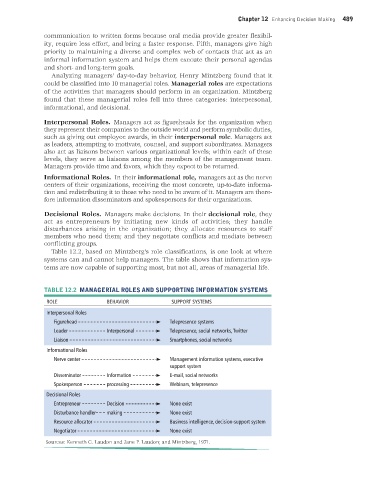Page 490 -
P. 490
Chapter 12 Enhancing Decision Making 489
communication to written forms because oral media provide greater flexibil-
ity, require less effort, and bring a faster response. Fifth, managers give high
priority to maintaining a diverse and complex web of contacts that act as an
informal information system and helps them execute their personal agendas
and short- and long-term goals.
Analyzing managers’ day-to-day behavior, Henry Mintzberg found that it
could be classified into 10 managerial roles. Managerial roles are expectations
of the activities that managers should perform in an organization. Mintzberg
found that these managerial roles fell into three categories: interpersonal,
informational, and decisional.
Interpersonal Roles. Managers act as figureheads for the organization when
they represent their companies to the outside world and perform symbolic duties,
such as giving out employee awards, in their interpersonal role. Managers act
as leaders, attempting to motivate, counsel, and support subordinates. Managers
also act as liaisons between various organizational levels; within each of these
levels, they serve as liaisons among the members of the management team.
Managers provide time and favors, which they expect to be returned.
Informational Roles. In their informational role, managers act as the nerve
centers of their organizations, receiving the most concrete, up-to-date informa-
tion and redistributing it to those who need to be aware of it. Managers are there-
fore information disseminators and spokespersons for their organizations.
Decisional Roles. Managers make decisions. In their decisional role, they
act as entrepreneurs by initiating new kinds of activities; they handle
disturbances arising in the organization; they allocate resources to staff
members who need them; and they negotiate conflicts and mediate between
conflicting groups.
Table 12.2, based on Mintzberg’s role classifications, is one look at where
systems can and cannot help managers. The table shows that information sys-
tems are now capable of supporting most, but not all, areas of managerial life.
TABLE 12.2 MANAGERIAL ROLES AND SUPPORTING INFORMATION SYSTEMS
ROLE BEHAVIOR SUPPORT SYSTEMS
Interpersonal Roles
Figurehead Telepresence systems
Leader Interpersonal Telepresence, social networks, Twitter
Liaison Smartphones, social networks
Informational Roles
Nerve center Management information systems, executive
support system
Disseminator Information E-mail, social networks
Spokesperson processing Webinars, telepresence
Decisional Roles
Entrepreneur Decision None exist
Disturbance handler making None exist
Resource allocator Business intelligence, decision-support system
Negotiator None exist
Sources: Kenneth C. Laudon and Jane P. Laudon; and Mintzberg, 1971.
MIS_13_Ch_12 global.indd 489 1/17/2013 2:30:30 PM

